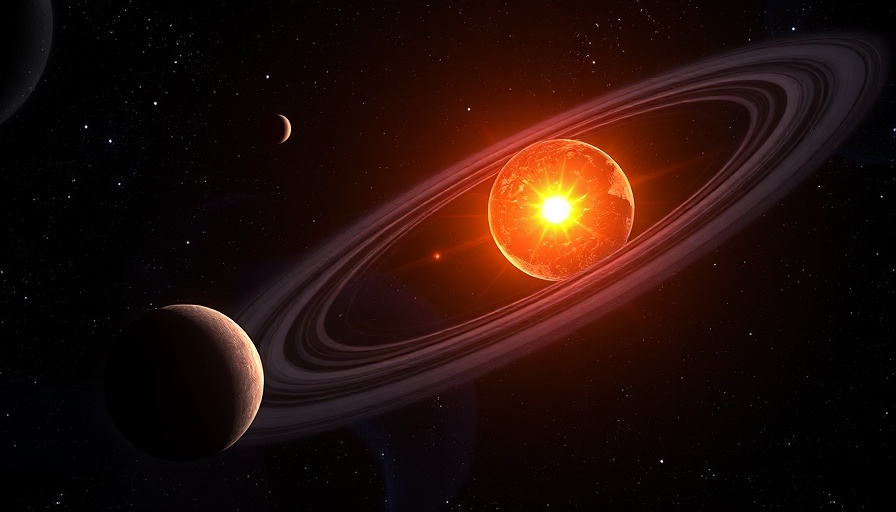
Barnard's Star: A New Era of Cosmic Discovery
Astronomers have made a groundbreaking discovery by confirming the existence of four tiny planets orbiting Barnard's Star, the second-closest star to Earth. The revelation provides exciting insights into planetary formation and the nature of the universe, marking a new chapter in our quest to understand our cosmic neighborhood.
Unveiling Four Rocky Worlds
Recent findings indicate that the four planets, each approximately 20-30% the mass of Earth, are located so close to their host star that they complete their orbits in mere days. Although this proximity likely renders them too hot for habitability, their discovery is significant in the ongoing search for smaller, rocky planets around nearby stars. Ritvik Basant, a Ph.D. student at the University of Chicago and lead author of the recent study, notes, "Stellar systems like Barnard's Star are key to understanding planet formation and stability across the universe." This research holds the potential to advance our understanding of exoplanetary characteristics and dynamics.
The Technology Behind Discovery: MAROON-X
The discovery was made using the MAROON-X instrument, developed for the Gemini Telescope in Hawaii. This precision tool allows astronomers to detect the subtle wobbles of stars caused by orbiting planets. By calibrating and analyzing data collected over three years, the team was able to discern signals related to the gravitational pull of the planets on Barnard's Star, hence determining their existence. This technique represents a significant leap forward from previous observational methods that struggled with noise interference.
The Historical Significance of Barnard's Star
Barnard's Star has been a focal point of astronomical curiosity since its discovery in 1916 by E. E. Barnard. Over the decades, there have been claims of planets associated with this star, yet none had been substantiated—labeling it as a “white whale” for planet hunters. The current confirmation marks the culmination of over half a century of studies, signaling a broader capability to explore and analyze M dwarf stars, which are abundant in our galaxy.
Understanding Planetary Composition
While researchers strongly believe these new planets to be rocky, definitive conclusions about their composition will be difficult without observing them crossing in front of Barnard's Star, a method that typically allows astronomers to determine if a planet is rocky or gaseous. However, by examining similar planets in other systems, scientists can make educated guesses about their compositions. Initial findings suggest these planets likely differ in their geological characteristics, a prospect that excites astronomers regarding the diversity and evolution of planetary systems.
Stability and Future Orbit Predictions
Due to their configuration, some scientists are questioning the long-term stability of the Barnard’s Star planetary system. Current models suggest that while the planets might maintain stable orbits over extended periods, factors influencing their stability require further research. The implications of this ongoing study could yield critical information about planetary interactions and how such systems evolve over time.
Implications for Habitability and Future Explorations
While none of the four planets lie within Barnard’s Star’s habitable zone, they provide a critical stepping stone in understanding the dynamics of exoplanetary systems. The identification of rocky planets in such close proximity to their stars challenges previous assumptions about where habitable planets may exist. Insights gained from this research can help refine the criteria for future missions looking for life beyond our solar system.
Why Does This Matter?
The discovery of these four planets is not just an academic triumph but a potential catalyst for public interest in space exploration and scientific discovery. The excitement surrounding Barnard's Star underscores the ongoing human endeavor to explore and understand our universe, fostering a spirit of inquiry and fascination that benefits society as a whole. As Ritvik Basant aptly summarizes: "We know a little more today than we did yesterday about our universe, and that sense of discovery is priceless."
Concluding Thoughts
The confirmation of these tiny planets around Barnard's Star opens doors to new research opportunities and deepens our understanding of planetary systems. The technological advances used in this discovery promise to revolutionize our quest for exoplanets in the coming years. Such milestones not only enhance our knowledge but also inspire future generations to continue exploring the cosmos.
As we continue to expand our horizons, it’s vital for everyone, from curious students to seasoned astronomers, to engage in this dialogue about our place in the universe. Stay informed and be part of the ongoing conversation about space exploration and discovery!
 Add Element
Add Element  Add Row
Add Row 



 Add Row
Add Row  Add
Add 


Write A Comment